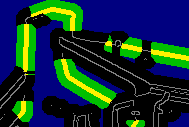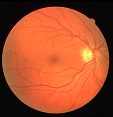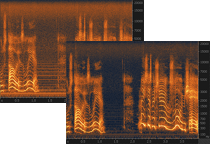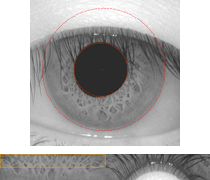 |
ResearchBiomedical image processingEnhancement algorithms for blinking fluorescence imagingYakov Pchelintsev, Andrey Nasonov Cell trackingAlexandr Kondratiev, Dmitry Sorokin Developing an automatic cell tracking approach for tracking of abruptly moving and dividing cell nuclei in 2D+t fluorescence microscopy image sequences. Histological Images Processing and AnalysisAlexander Khvostikov, Andrey Krylov Our research is focused on developing algorithms for:
Image enhancementAndrey Nasonov, Alexey Lukin, Alexandra Nasonova, Andrey Krylov  Resolution enhancementThe problems of image and video resampling and multiframe superresolution are considered. They are posed as ill-posed inverse problems. Regularization methods based on Tikhonov regularization are used to solve there problems. We also consider developing fast and low complexity edge-directional resizing algorithms for image and video.  Image sharpening by grid warpingA new technique to perform edge sharpening using grid warping is proposed. The idea of grid warping is to move the edge neighborhood pixels closer to the edge. The proposed algorithm is not posed as a global image deblurring method. It enhances only image edges neighborhood and practically does not affect image textures. The proposed sharpening algorithm has the following features:
Rank algorithmsThe problem of development of fast rank algorithms for image enhancement is considered. Based on multiscale histograms and using lazy histogram updating technique we developed fast calculation scheme for finding
Image analysis Basic edgesWe consider the problem of evaluation of image enhancement algorithms like resampling, deringing, deblurring. The main idea is to find the areas where typical artifacts of image enhancement algorithms usually appear: blur and ringing artifacts. The main idea is to find edges that are the most suitable for image quality analysis — the basic edges. The following constrains are imposed:
Special metrics (BEP, BEN) are used to estimate the image quality in the neighborhood of the basic edges. Edge width estimationAlexandra Nasonova, Andrey Krylov Development of edge width estimation algorithm is important for image enhancement and image quality analysis methods. We aim at developing an edge width estimation algorithm that is robust to image artifacts and noise.  Ringing detection and suppressionAndrey Nasonov, Andrey Krylov Ringing effect so known as Gibbs phenomenon in mathematical methods of image processing is the annoying effect in images and video appeared as rippling artifact near sharp edges. This effect is caused by distortion or loss of high frequency information in image. It can be found in images of different classes: MRI images, compressed images, oversharpened images, images transmitted over analog channel etc. Our research on ringing effect has the following directions:
 Keypoints and descriptorsKeypoints detection and local image descriptors construction is one of the basic problems in image analysis. The keypoints detection and descriptors construction algorithms are based on Gauss-Laguerre circular harmonic functions (CHFs) image expansion. The interconnection between Gauss-Laguerre CHFs and 2D Hermite functions in conjunction with fast Hermite projection method is used to accelerate the computation. The subjects of the current research are:
GeologyLumenStone DatasetAlexander Khvostikov Medical image processing Retinal image processing and analysisAndrey Nasonov, Alexander Semashko, Alexandra Nasonova, Vladmir Sergeev, Andrey Krylov Developing a system for automatical processing of retinal images to assist a doctor to make a diagnosis. The project includes:
 Computer Tomography image filteringNikolay Mamaev, Alexey Lukin, Dmitry Yurin The subject of this research is to develop effective algorithm for image filtering based on local pixels neighborhood decomposition by using Hermite functions.  Audio signal analysis and processingAlexey Lukin, Maxim Tkachenko Audio noise reductionA spectral subtraction method for reduction of a stationary noise in audio signals leaves a well-known artifact called "musical noise" — a series of random energy bursts on a time-frequency plane. We are developing 2D smoothing methods for prevention of this artifact, and using multiresolution STFT techniques to improve time and frequency resolution of the method. Multiresolution analysis and processingFilter banks with fixed time-frequency resolution, such as the Short-Time Fourier Transform (STFT), are a common tool for many audio analysis and processing applications allowing effective implementation via the Fast Fourier Transform (FFT). The fixed time-frequency resolution of the STFT can lead to the undesirable smearing of events in both time and frequency. We suggest adaptively varying STFT time-frequency resolution in order to reduce filter bank-specific artifacts while retaining adequate frequency resolution. Several strategies for systematic adaptation of time-frequency resolution are proposed. The introduced approach is demonstrated as applied to spectrogram displays, noise reduction, and spectral effects processing. Biometrics Iris recognitionElena Pavelyeva, Andrey Krylov Iris data pre-processing and parametrization by Hermite functions. Recognition of iris images. Hermite projection method is used for human iris identification. Expansion of iris intensity information into a series of eigenfunctions of Fourier transform enables us to perform information analysis of the signal and its Fourier transform at the same time. Effectiveness of the method with test iris database images is shown. |
|

